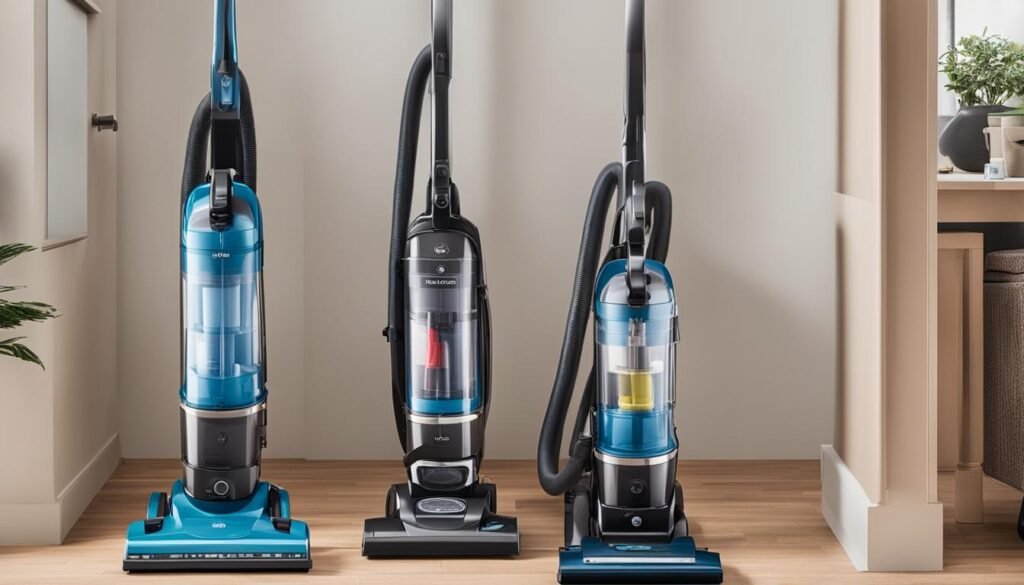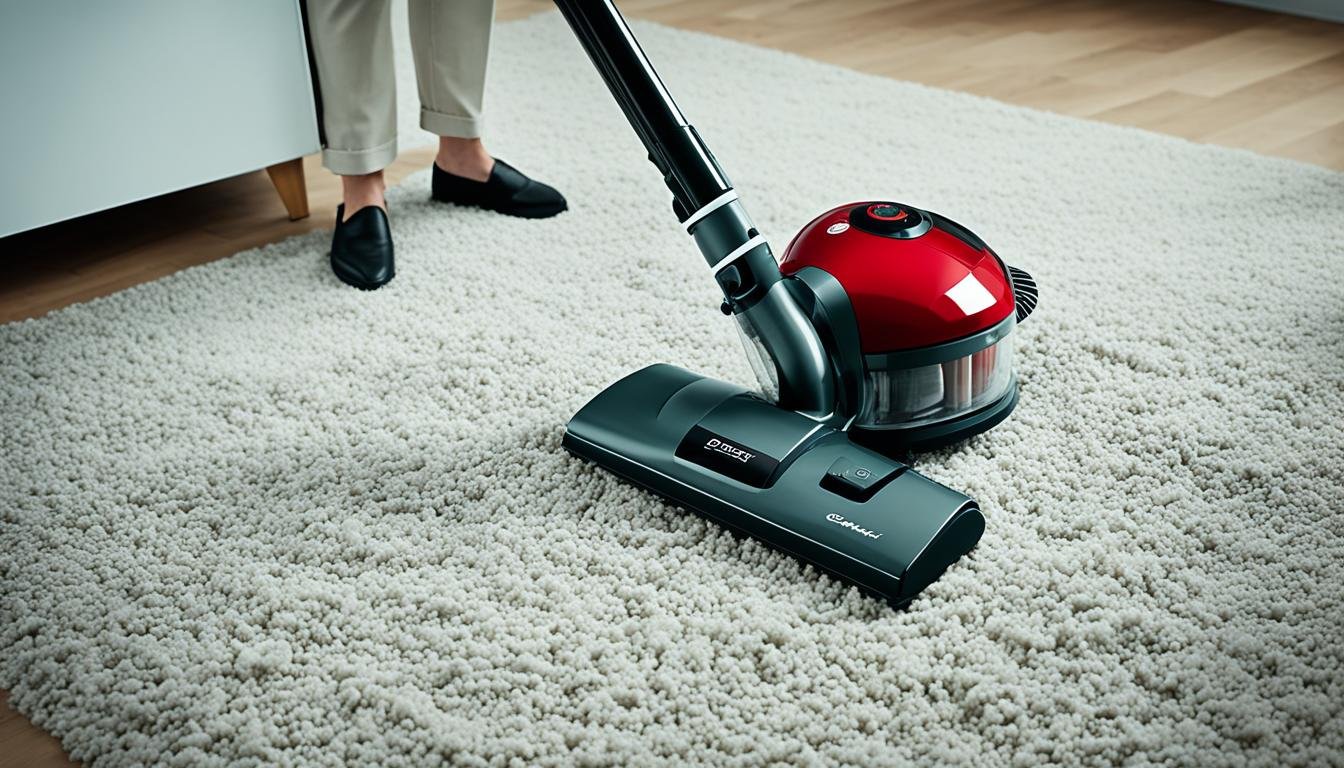When it comes to keeping your home clean and free from dust and allergens, a reliable vacuum cleaner is a must-have. Whether you call it a vacuum cleaner or a vaccum cleaner, this household appliance is designed to make your cleaning tasks easier and more efficient. But with so many options available on the market, how do you choose the right one for your needs? In this article, we will explore the top features of vacuum cleaners, helping you unlock the power of a clean home.
Key Takeaways:
- Consider the motor input power, measured in watts, to determine the cleaning performance of a vacuum cleaner.
- Water lift ratings indicate a vacuum cleaner’s ability to pick up heavier soils, making it ideal for high filtration or HEPA filtration systems.
- Airflow is a crucial specification that determines a vacuum cleaner’s cleaning ability, with canister vacuum cleaners requiring an airflow of 100 CFM or more for optimal performance.
- Upright vacuum cleaners come in different designs, including “Direct Air” or “Dirty Air” design and by-pass motor design, and airflow ratings of 60 CFM or better indicate high performance.
Now that you understand the important specifications to consider when comparing vacuum cleaners, let’s dive deeper into the suction power and how to choose the right vacuum cleaner in the next section.
Choosing a Vacuum Cleaner – Suction Power Guide
When it comes to selecting a vacuum cleaner, one of the key factors to consider is the suction power. The ability of a vacuum cleaner to effectively clean your home depends on its suction capabilities. In this section, we will explore how to evaluate suction power and other important specifications to make an informed decision.
For canister vacuum cleaners, suction power is typically measured in CFM (cubic feet per minute). Ideally, a canister vacuum cleaner should have an airflow rating of 100 CFM or higher. This high airflow ensures that the vacuum cleaner can effectively pick up dirt and debris, leaving your floors spotless.
On the other hand, upright vacuum cleaners often indicate suction power using motor amps. While amps alone may not accurately represent a vacuum cleaner’s cleaning ability, it is still a valuable specification when comparing different models. Higher motor amps generally indicate a more powerful suction, but it’s important to consider other factors as well.
In addition to suction power, there are several other features and specifications to consider when choosing a vacuum cleaner. These include the type of filtration system, brush roll options, and the attachments available. The filtration system determines how effectively the vacuum cleaner can trap dust and allergens, while the brush roll options and attachments enhance its versatility for different cleaning tasks.
“A vacuum cleaner with a high CFM and a versatile set of features can make all the difference in maintaining a clean and healthy home.”
In conclusion, when selecting a vacuum cleaner, it’s crucial to consider the suction power, along with other features and specifications such as filtration system, brush roll options, and attachments available. Investing in a vacuum cleaner with optimal suction power and a versatile feature set can greatly enhance your cleaning experience and help you maintain a clean and healthy home.
Bagged vs. Bagless Vacuum Cleaners – Pros and Cons
When it comes to choosing a vacuum cleaner, one of the primary considerations is whether to opt for a bagged or bagless model. Both options come with their own set of pros and cons, and it’s essential to understand them before making a decision.
The Pros of Bagged Vacuum Cleaners
- Effective Filtration: Bagged vacuum cleaners use disposable bags as the filter media, effectively trapping dirt and dust inside the bag. This ensures that the air expelled is cleaner and reduces the risk of allergens and other particles circulating in your home.
- Less Maintenance: Bagged models require less maintenance as the bag serves as a barrier, preventing debris from coming into direct contact with the vacuum cleaner’s filters and motor.
- Easy Disposal: When it comes time to dispose of the collected dirt and debris, you simply remove the bag and throw it away without the risk of releasing a cloud of dust.
The Cons of Bagged Vacuum Cleaners
- Additional Costs: Bagged vacuum cleaners require the purchase of replacement bags. While they may seem cost-effective in terms of bag replacements, it’s important to factor in the cost of purchasing new bags over time.
- Reduced Suction Power: As the bag fills up, the suction power of a bagged vacuum cleaner can decrease. This means that you may need to replace the bag more frequently to maintain optimal cleaning performance.
The Pros of Bagless Vacuum Cleaners
- Convenience: Bagless vacuum cleaners have gained popularity due to the convenience of not needing to purchase replacement bags. With a bagless model, you can simply empty the dirt receptacle when it’s full.
- Cost Savings: Bagless models may initially appear more cost-effective as they eliminate the need for purchasing replacement bags. However, it’s important to consider the cost of filter replacements, as bagless models typically have an onboard filter that needs periodic replacement.
The Cons of Bagless Vacuum Cleaners
- Proper Dust Disposal: Emptying the dirt receptacle of a bagless vacuum cleaner can be challenging, as it can lead to the release of a cloud of debris. It’s important to handle the process carefully to prevent the spread of dust.
- Filter Maintenance: Bagless vacuum cleaners require the periodic replacement of onboard filters to maintain optimal performance and air quality. This additional maintenance should be taken into consideration when comparing costs.
Ultimately, the choice between a bagged and bagless vacuum cleaner depends on your specific needs and preferences. Consider the pros and cons outlined above, and take into account factors such as vacuum cleaner reviews, the vacuum cleaner price, and the best vacuum cleaner for your needs. By weighing these considerations, you can make an informed decision and find the vacuum cleaner that best suits your cleaning needs.

Conclusion
When it comes to choosing the right vacuum cleaner, it’s essential to consider key specifications that affect its performance. Motor input power, water lift, and airflow are crucial factors to evaluate. For optimal cleaning performance, canister vacuum cleaners with higher CFM ratings and greater water lift are recommended. On the other hand, upright vacuum cleaners have different designs, and amp ratings provide insights into their cleaning ability.
Another significant consideration is whether to opt for a bagged or bagless vacuum cleaner. Bagless models offer convenience by eliminating the need for replacement bags. However, it’s important to factor in the cost of periodic filter replacements. Bagged vacuum cleaners, on the other hand, use disposable bags as filter media, effectively trapping dirt and dust. While bagless models seem cost-effective, both options have pros and cons that must be weighed accordingly.
To make an informed decision, it’s crucial to research reputable vacuum cleaner brands. By considering the aforementioned factors and exploring top-rated vacuum cleaner brands, you’re more likely to find a vacuum cleaner that meets your cleaning needs and preferences. With the right vacuum cleaner in your arsenal, you can maintain a clean and tidy home with ease.
FAQ
What are the important specifications to consider when comparing vacuum cleaners?
The important specifications to consider when comparing vacuum cleaners are motor input power, water lift, and airflow.
How is suction power measured in canister vacuum cleaners?
Suction power in canister vacuum cleaners is typically measured in CFM (cubic feet per minute).
How is suction power indicated in upright vacuum cleaners?
Suction power in upright vacuum cleaners is typically indicated by motor amps.
What other features and specifications should I consider when selecting a vacuum cleaner?
Other features and specifications to consider include the type of filtration, brush roll options, and available attachments.
Should I choose a bagged or bagless vacuum cleaner?
The choice between a bagged or bagless vacuum cleaner depends on personal preference. Bagless models offer convenience, while bagged models effectively trap dirt and dust in disposable bags.





Leave a Reply